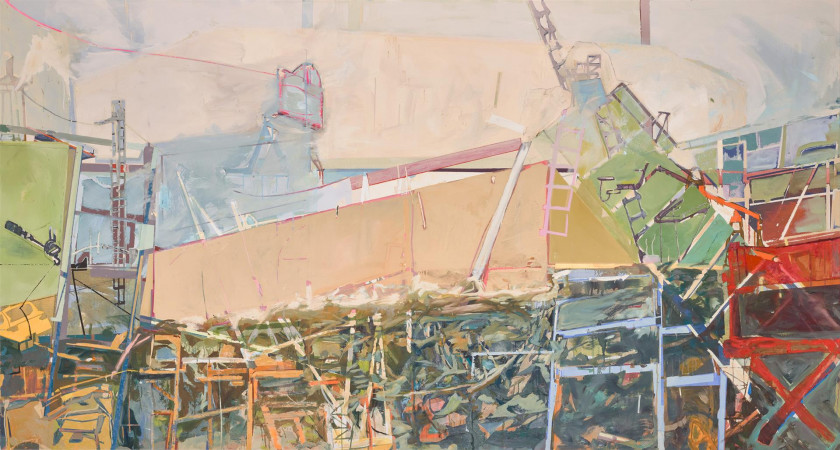Paisagem Nº77 [Landscape Nº77]
painting


2014
Acrylic and oil on canvas
150 x 280 cm
“The World is what you see from where you are”. The statement by the Brazilian conceptual geographer, Milton Santos, has become a leitmotiv of Lucia Laguna’s approach to painting. Direct observation is precisely at the core of Laguna’s architectural and exuberant style. From her studio in Mangueira, a suburb in the vicinity of Rio de Janeiro, the windows are as many magnetic vantage points on the surrounding landscape with its buildings, steel constructions, houses, and favelas.
As an autodidact and arriving to painting in later life, Laguna progressively developed a specific creative process involving successive acrylic and oils strata. First primed with acrylic by assistants, the canvas is ready for her several interventions using oil paints. Saturating the surface with intermingled geometries and figurative motives, she then recovers selected portions of the dried painting with large strips. At that point, she boldly applies new layers of flat colours with spatulas, thus overlapping the non-covered parts. While removing the strips, she discovers the final result with its dynamic between the newly repainted and the untouched areas. By integrating randomness, the whole process tends to emphasise abstraction.
Recognisable architectural and urban elements such as the mill at the forefront, electric poles and towers, beams and cables, houses and windows stand against the compact and densely built landscape. This urbanised scenery is rendered by smudged colourful zones and lines of different size and width extending in all directions. The palette is contrasted with green, grey and blue, touches of pink, red, purple and orange, and the large creamy-salmon and whitish-blue flat sections in the upper part.
Free from any representational motto that would seek accuracy, exactitude and preciseness, Laguna expresses her personal viewpoints and experience of the world by means of reality-anchored compositions. Thus, the improvisation, the palimpsest and chance components open mnemonic and oneiric dimensions.
Katherine Sirois